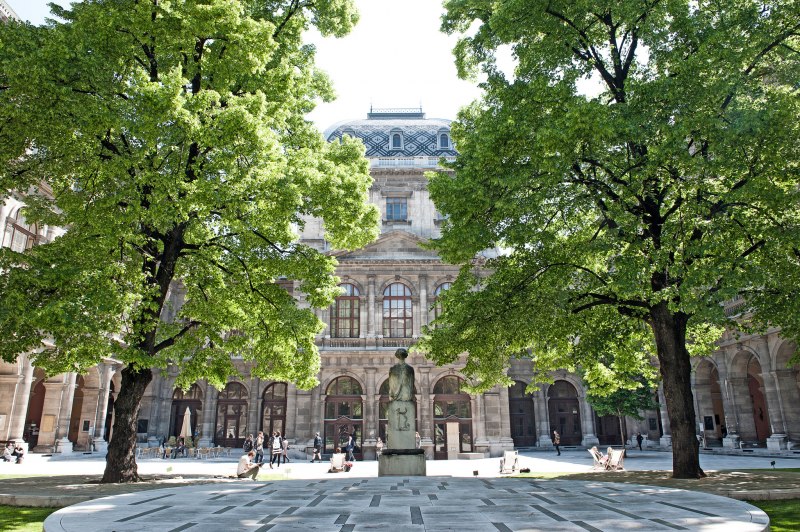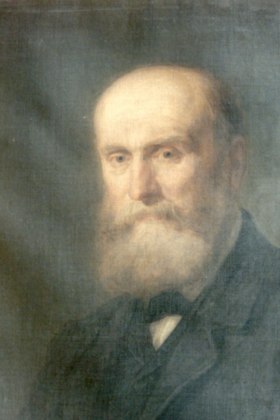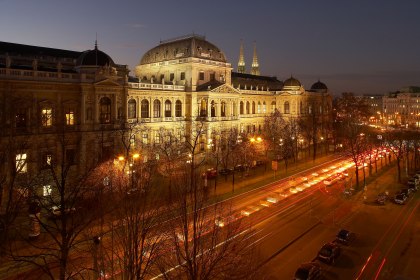The Arkadenhof (arcaded courtyard) in the main building of the University of Vienna
The Arkadenhof (arcaded courtyard) forms the architectural center of the main building of the University of Vienna. Architect Heinrich von Ferstel made it the focal point of the paths connecting the four massive building parts around it: the ceremonial hall tract at the Ringstraße, opposite it the library tract, and both teaching buildings with lecture halls and institutes on the long sides.
Ferstel and his advisor Rudolf von Eitelberger not only planned a spatial, but also spiritual heart for the university. According to their ideas, the courtyard was also meant to represent a memorial space that with its statues and honorary plaques was to become the honorary site of the Alma Mater Rudolphina. With the implementation of their plans over the following decades, a unique ensemble of sculpted professors’ portraits arose.
Modeled on Italian Renaissance architecture
With its length of 70 meters and width of 45 meters, the Arkadenhof possesses the dimensions to match its intended monumental character. Above the arcades erected in Tuscan order, arched windows with Ionic half-columns look out over the courtyard from the second floor. The third floor is fitted with rectangular windows, separated by Corinthian half-columns. The architect said that this design was based on the Palazzo Farnese by Antonio de Sangallo the Younger in Rome. However, detailed art historical analysis has found indication that the convent of the Order of Santa Maria della Carità begun by famous Renaissance-architect Andrea Palladio in Venice also was a model for Ferstel.
The courtyard was planned as a substitute for the old university square in the Stubenviertel as a meeting place and space for communication, and as a forum for events and demonstrations. Because of this, Ferstel designed paving for the whole courtyard area, rich with ornaments. This plan was unfortunately never realized. When the main building was opened, coarse gravel was deemed sufficient; in 1888 it was decided that the courtyard would be made greener in the style of a park, which was finally done in 1890. In the anniversary year of 1965, the green space of the Arkadenhof was redesigned.
Redesign of the Arkadenhof
The plans for the redesign and renovation of the Arkadenhof in 2005/06 originally included Ferstel’s original idea of paving the whole courtyard. This would have facilitated events and functions. However, the removal of the grass areas was met with protests, so a compromise was found. All bushes and the grass in the front area between Aula (antechamber) and Castalia-fountain was removed and replaced by slabs of stone, while the back area received a new lawn. In the course of these renovations, the war monument („Siegfriedskopf“) was moved from the Aula to the Arkadenhof. The arcades themselves were made colorful, as per Ferstel’s design, the arched roofs were renovated and all monuments were cleaned.
„University’s Valhalla“
Ferstel’s design concept not only included the statues of famous scholars in the arcades, but also the construction of a monumental equestrian statue for the university’s founder Rudolf IV in the center of the courtyard. This was never implemented. Instead, the fountain statue of Castalia was erected in 1910. The vote on the scholar statues on the other hand passed the Academic Senate in 1884, shortly after the main building had been opened. The first one, a statue for criminal law professor Julius Glaser, was already unveiled in 1888. It was followed by several portrait sculptures that were relocated from the Old University as well as from the General Hospital , subsequently leading to a veritable “flood” of monuments until the First World War. Until 2002 more than 150 statues were erected in the arcades.
„The muse has had enough“
Unfortunately, the sculpted representations of academic science are all male. Only one plaque is dedicated to a woman: the poet and honorary doctor Marie von Ebner-Eschenbach. Not a single woman was honored for her scientific accomplishments. This has been addressed by several artistic initiatives and interventions in recent years: In 2005 the monument for anonymized female scientists 1700-2005 (Elise Richter) by artist Elisabeth Penker was temporarily erected, followed in 2009 by the installation „Der Muse reicht’s“ (“The muse has had enough”) by Iris Andraschek , commemorating scientific accomplishments of women at the University of Vienna. In the celebratory year 2015 the exhibition „Radical Busts“ will counteract the gender representation in the Arkadenhof with 33 golden busts by artist Marianne Maderna honoring academic accomplishments by women.
On 30 June 2016 the first seven monuments for female academics were unveiled in the arcaded courtyard of the University of Vienna: to psychologist Charlotte Bühler, social scientist Marie Jahoda, physicists Berta Karlik and Lise Meitner, archaeologist Grete Mostny, linguist Elise Richter and mathematician Olga Taussky-Todd.
Overview of monuments
Detailed information on all monuments in the Arkadenhof can be found on the wiki-platform u:monuments.
-

Arkadengang im Hauptgebäude der Universität Wien, 1927
-

Arkadengang im Hauptgebäude der Universität Wien nach der Neugestaltung 2005–2006
-
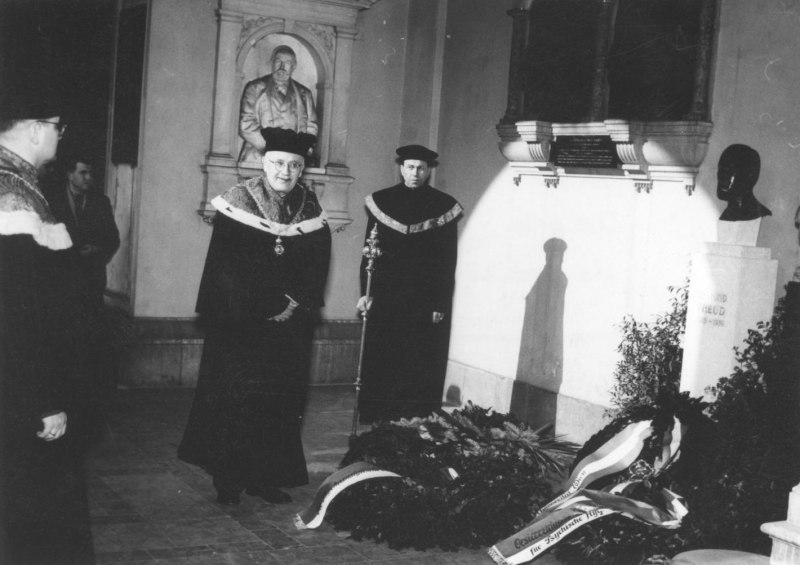
Enthüllung des Denkmales für Sigmund Freud im Arkadenhof der Universität Wien
In Anwesenheit des Rektors Johann Radon wurde 1955 die Büste für Sigmund Freud enthüllt.
-
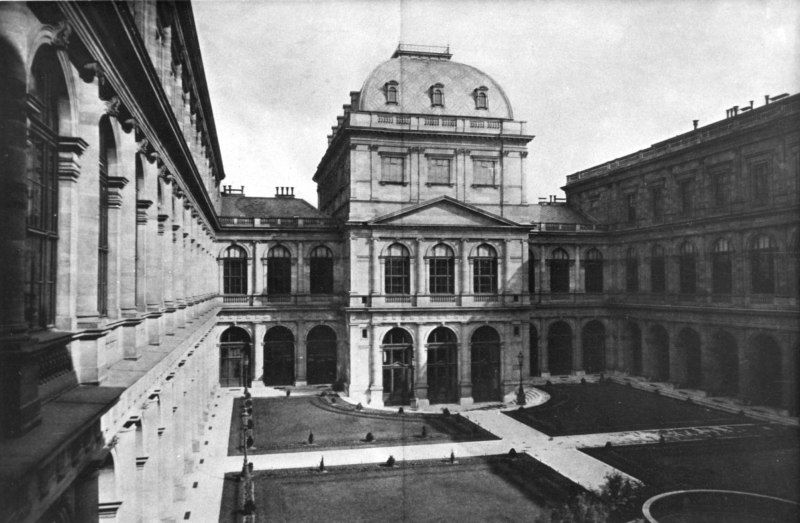
Ansicht des Arkadenhofes der Universität Wien vor 1910
Das Bild zeigt den Arkadenhof nach seiner Begrünung (1890) und vor der Errichtung des Kastaliabrunnens (1910).
-

Kastaliabrunnen von Edmund Hellmer im Arkadenhof, um 1965 nach der Neugestaltung des Hofes
Zuletzt aktualisiert am : 25.06.2024 - 11:05
-
Gelehrte in Stein und Bronze
19. Jhdt.–20. Jhdt. -
Die „Arisierung“ des Arkadenhofs
1938

